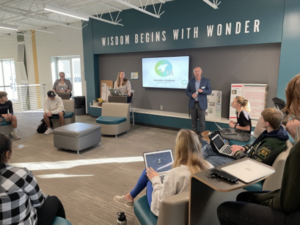21st Century Learning, At All Levels

Last Friday, Mark Edmundson, an English professor at The University of Virginia, wrote a scathing critique of online learning in The New York Times. Mr. Edmundson’s understanding of his subject lacked an in-depth intellectual or practical study of the myriad diverse programs available to students from grade school to graduate school. Unfortunately for his readers, and dangerous for those new to the concept, the basis of Mr. Edmunson’s argument against innovative teaching and learning practices seems to be rooted in a casual observation of a videotaped lesson; a form of distance learning, certainly, but one that is perhaps the most basic and dated of examples. His singular interaction with online learning does not constitute a fair judgment of today’s teachers using online curriculum and web-based learning environments to increase access and move millions of students forward in preparation for college and careers.
More than half of high schools in the United States report they need online learning to provide excellent teachers to students without localized access – leveling the playing field and personalizing instruction for students through online courses otherwise unavailable and allowing them to earn credits needed for graduation. Online courses require discussion, reflection, a heavier emphasis on writing than most lecture classes, and individualized instruction using digital resources for learning beyond a single textbook. A Project Tomorrow study showed that the reasons students seek online learning include personalized instruction, flexibility, extra attention and to “get more help from teachers”.
Learning doesn’t happen only in a lecture hall, a lab, or a classroom in the 21st century. Today’s students must become better prepared for global competitiveness with technology-based literacy skills that include research, analysis of complex data from multiple resources, problem-solving and effective communication. Students deserve to access the best teachers any time, any place with flexible pacing to allow acceleration of their learning paths. To meet unique individual needs, today’s schools are combining a high tech, high touch approach centered around students — offering excellent teaching that requires advanced communication and critical thinking skills.
Online teachers will tell you that they get to know their students much better as they are learning online, unfettered by the walls of a traditional classroom or a bell schedule, opening them up to reflection, thoughtful responses, and more freedom to share academic ideas. And just as great classroom teachers don’t teach “at” their students, great online teachers don’t either. Meet our National Online Teacher of the Year, Leslie Fetzer — you will wish she could be working with your students on learning advanced concepts in science.
At every level, online learning offers students an opportunity to explore their education at their own pace. Edmundson misses the fact that it is nearly impossible to engage and personalize instruction using only a single textbook in a traditional classroom with twenty kids. Few would call what a great teacher can do with technology tools online to personalize learning experiences “one-size-fits-all”.





0 Comments
Leave a Comment
Your email address will not be published. All fields are required.